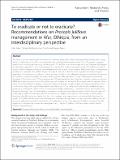| dc.description.abstract | As one of the most invasive species of arid and semi-arid areas of East Africa, Prosopis juliflora has become a major
threat to livelihoods of the Afar pastoral people and to the fragile ecosystems they live in. This paper comprises
results from a multidisciplinary study on the spread of P. juliflora as an invasive species in the Ethiopian Afar Region
and provides suggestions on its management and control. The study investigated spread of P. juliflora, ecological
aspects (shifts in vegetation biomass and soil properties) and socio-economic aspects (livelihood impacts, management
activities and potential) of P. juliflora invasion. Ecological methods included conducting destructive harvesting on
vegetation; soil analyses and a soil seed bank assessment as well as using allometric equations to estimate the biomass
and carbon contents of P. juliflora. Socio-economic data was collected based a survey of 490 pastoral households
including 213 from Amibara, 177 from Gewane and 100 from Awash Fentale. Stated and revealed preference methods
(RPM) were used because impacts of P. juliflora are both tangible and intangible. The study found that wetlands (flood
plains in the Awash Basin) are highly susceptible to Prosopis invasion relative to drylands. Clearing invaded land and
continuously using it for crop farming would reduce the invasion. The study also found that the available nitrogen,
phosphorus and organic carbon in the soil were high in highly invaded areas compared to less or non-invaded sites.
However, the basal cover of native herbaceous vegetation and native tree diversity were found to be much reduced
under high P. juliflora-invaded areas. Results from economic analyses also reveal that the benefits of the P. juliflora
invasion in the Afar region are higher than the costs. However, some aspects such as increased risk of erosion, the
impact of P. juliflora on the water table and long-term ecological changes were not examined, thus making the total
economic valuation incomplete. Nonetheless, the study has captured most aspects of P. juliflora invasion in the Afar
region and concludes that sustainable management and control of P. juliflora in the Afar region may be a better
solution than eradication. | en_US |

